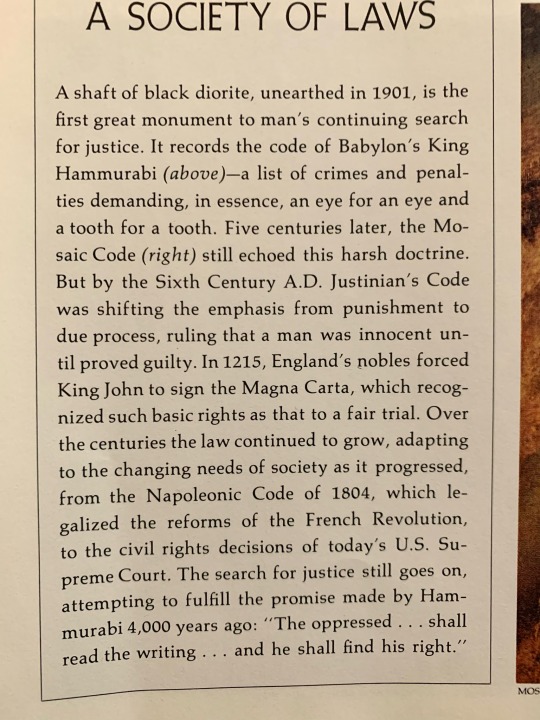#The Code of Hammurabi
Quote
And only you can still clarify the Vedas, Talmud, the Bible, Tao Te Ching, the laws of Hammurabi, Apocrypha, cromlechs, pregnant goddesses, Bogomils, medieval hymns, round stones in Guatemala, coral trees, anagoges, Hindu columns!
Raša Livada, The Horse Has Six Legs: An Anthology of Serbian Poetry
#Serbian#Raša Livada#The Vedas#The Talmud#The Bible#Lao Tzu#Tao Te Ching#Hammurabi#The Code of Hammurabi#The Biblical Apocrypha#Cromlech#Dea Gravida#Bogomil#Bogomilism#Architecture#Art#Culture#References
2 notes
·
View notes
Text
To all the millions of people and not that I'm sure will read this post, I have something to tell you.
I wrote a new story:
RomComPar

(Don't mind the mess, I'm not an artist.)
You can read it on Tapas or Honeyfeed
It's kind of a parody of manga romcoms (never would have guessed), and kind of whatever I wanted to write, but the main point is that it's funny
I already posted the first two chapters, and the third will be posted in a couple of days.
Now go read it, multiple times if you could so that it shows up more on the home
#oc#story#creative writing#art#i think#tapas#honeyfeed#funny#the code of Hammurabi#i dont know how to use tags#what do you want?#trends#relatable#the pope?#webnovel#light novel#ya
0 notes
Text
ROUND 2: SPOCK (star trek) VS HAMMURABI (real)


#tournament#now kill#g2#spock#star trek#tos#star trek tos#st tos#hammurabi#hammurabi's code#hammurabi's cock
292 notes
·
View notes
Text
✨🦁✨
🥴💦
#dislyte#shamash#javid#I assume those dark cuneiform-covered pillars he summons are evocative of the Code of Hammurabi stele
116 notes
·
View notes
Text


I was reading a book about Ancient Mesopotamia, and came across this mention of the Napoleonic Code:
Over the centuries the law continued to grow, adapting to the changing needs of society as it progressed, from the Napoleonic Code of 1804, which legalized the reforms of the French Revolution
Source: Samuel Noah Kramer, Cradle of Civilization
The book is about what is believed to be the first civilization, and how it’s own developments (writing, urbanization, law, trade, etc) have impacted and laid the foundation for societies to this day. Really amazing to see how history is all connected.
#interesting#napoleonic#Mesopotamia#napoleonic code#code of Hammurabi#cradle of civilization#Samuel Noah Kramer#Kramer#book pic#Sumer#Sumerian#frev#french revolution#napoleon#Napoleonic era#history#book pics#ref#first french empire#french empire
28 notes
·
View notes
Text
Unearthing Ancient Civilizations
The Importance of Over 30,000 Preserved Cuneiform Writings
Deciphering a Lost Language
Insights into Daily Life and Culture
The Epic of Gilgamesh
Technological and Scientific Advances
Religious and Mythological Texts
The Role of Cuneiform in Modern Research
Challenges in Preservation and Interpretation
Enhancing Accessibility and Understanding
Book Recommendations
Online Resources and…

View On WordPress
#Assyriology#Babylonian mathematics#British Museum#Code of Hammurabi#Cuneiform#Cuneiform Digital Library Initiative (CDLI)#Epic of Gilgamesh#Henry Rawlinson#Louvre Museum#Mesopotamia#Mesopotamian mythology#Sumerians
6 notes
·
View notes
Text
What incredibly hyperfocused project did you put absolutely too much effort into when you were in grade school? Answer in the tags
#i made a copy of the code of hammurabi#with all the cuneiform and everything#by which i mean i sculpted one out of clay
21 notes
·
View notes
Text

Captain Constance L. Hanaway of the first division, FDCM
#oc#my art#sun-floweroo#my drawing#sketch#oc art#story#story ideas#Hammurabi’s code#Hammurabi’s code oc#original character#original story
4 notes
·
View notes
Text
37 Lost Books on Ancient Mesopotamia
The Lost Book Project is charging $12 for this collection. If you found this roundup useful, please consider donating to the Internet Archive instead.
The Epic of Gilgamesh by A. George (1999)
Enuma Elish: The Seven Tablets of Creation by L. W. King (1900)
Ancient Iraq by G. Roux (1964)
History Begins at Sumer: Thirty-Nine Firsts by S. Kramer (1956)
The Code of Hammurabi by Hammurabi (1905)
The Sumerians: Their History, Culture, and Character by S. Kramer (1963)
Ancient Mesopotamia: Portrait of a Dead Civilization by L. Oppenheim (1964)
The Ancient Near East - An Anthology of Texts and Pictures by J. Pritchard (1958)
Babylonian Magic and Sorcery by L. W. King (1896)
The Sumerians by C. Leonard Woolley (1920)
The Religions of Ancient Egypt and Babylonia by A.H Sayce (1901)
Babylonian and Assyrian laws, Contracts and Letters by C. H. W. Johns (1904)
The Richest Man in Babylon by G.S Clayson (1926)
A history of the Babylonians and Assyrians (2nd Edition) - G. S. Goodspeed (1902)
Assyria, its Princes, Priests, and People - A. Sayce (1885)
The teachings of Zoroaster, and the philosophy of the Parsi religion by S. A. Kapadia (1913)
An old Babylonian Version of the Gilgamesh Epic by M. Jastrow (1920)
Assyrian and Babylonian Religious Texts; Prayers, Oracles, Hymns. Copied from the original tablets by J. A. Craig (1895)
Babylonian and Assyrian literature - comprising the epic of Izdubar, hymns, tablets, and cuneiform inscriptions - E. Wilson (1901)
Babylonian Boundary Stones and Memorial Tablets in the British Museum Vol. 1 by L. W. King (1912)
Babylonian Boundary Stones and Memorial Tablets in the British Museum Vol. 2 by L. W. King (1912)
Chaldean Account of Genesis - Containing the Description of the Creation, the fall of man, the deluge, the tower of Babel, the times of the patriarchs, and Nimrod - G. Smith (1876)
Cuneiform Parallels to the Old Testament by R. W. Rogers (1912)
Discoveries Among the Ruins of Nineveh and Babylon - A. Layard (1853)
Myths & Legends of Babylonia & Assyria - L. Spence (1916)
Myths of Babylonia and Assyria by D. A. Mackenzie (1915)
The Babylonian Legends Of Creation by E. A. Wallis-Budge (1921)
The Chaldean Account Of The Deluge by G. Smith (1873)
The Code of Hammurabi by P. Handcock (1920)
The Code of Hammurabi, King of Babylon about 2250 B.C. by R. F. Harper (1904)
The Devils and Evil Spirits of Babylonia Vol. 1/2 (1903)
The Law of Hammurabi and Moses; a sketch by H. Grimme (1907)
The Religions of ancient Egypt and Babylonia - A. Sayce (1902)
Reports of Magicians and Astrologers of Nineveh and Babylon in the British Museum - Vol 1 - R. Thompson (1902)
Reports of Magicians and Astrologers of Nineveh and Babylon in the British Museum - Vol 2 - R. Thompson (1902)
6 notes
·
View notes
Text

hey guys.
#do we think the ancient babylonians who wrote the code of hammurabi read homestuck. be honest#shamsisms
16 notes
·
View notes
Text
In a period in which there were major changes taking place in property and political relations, the shifting importance of certain issues for lawmakers and compilers can tell us something about an attendant shift in values. The increasing emphasis in Mesopotamian law codes on the regulation of property crimes, the rights and duties of debtors, the control of slaves, and the regulation of the sexual conduct of women tells us that issues of gender, class, and economic power were problematic and demanded definition and that such definition linked these subjects in quite specific ways. Similarly, the severity of punishment for specific crimes is an indication of the values held by the community at the time of the codification of the laws. The Codex Hammurabi exacts the death penalty for: certain kinds of theft; housebreaking; connivance in slave escapes; faulty building construction which results in fatal accidents; black magic; kidnapping; brigandage; rape; incest; for causing certain kinds of abortions; and for adultery committed by wives.
-Gerda Lerner, The Creation of Patriarchy
#gerda lerner#patriarchy#code of hammu#the codex hammurabi#ancient law#female oppression#women as property
7 notes
·
View notes
Note
Did you say football au?
i did! im trying to figure out what it was through my sickness-induced brain fog... i think it was a charlos au, where carlos plays for real madrid and theres that charity match and thats where he and charles meet and then its all like. idek. trying to keep the relationship from the media and sneaking around and carlos coming to races and charles going to games. ive had something written somewhere but fuck me if i know what, or where, or in which medium actually.....
#lord give me strength through this sickness#akira answers asks#lovely anons#the wip list is just like. hammurabi code#no thats not quite it theres another example#like... its a rly long list....
10 notes
·
View notes
Text
do I write the artem wing x saeyoung choi one-shot or...?
#me when I realize my 2 favorite male presenting love interests are genuinely compatible#shocked pikachu face#mod mumbles#they both like fishing and cars and have strong senses of justice!#except artem believes in the legal system and saeyoung believes in hammurabi's code#But they're both committed to the bit#also autistic coded... so very autistic coded.....
2 notes
·
View notes
Text
有口難言
The first one is from a peom, 醉睡者(zuì shuì zhě; a drunk sleeping person) by 蘇東坡(sū dōng pō) in 宋朝(song dynasty).
有道难行不如醉, 有口难言不如睡.
if it's difficult to act then be drunk, if it's difficult to say then just sleep.
先生醉卧此石间, 万古无人知此意.
I lie on the gravels, the reason why, no one would know.
This is as the title said, about a person who's drunk. The poet was talented but hapless. Mostly lamenting about his situation. Its literal meaning is, I have mouth but difficult to say.
In here, I think Wen kexing told that idiom not only to Zhao jing but himself as well, just the place where they were, has changed. Wen kexing was difficult to say before but now it is Zhao jing.

眾叛親離
This is from 詩經(shi jing; Classics of poem), it is in one of the chapter, 國風(guo feng). Also it has 160 peaces of poem, and this is from 邶風(Bei feng; bei nation's fork song). The title is 擊鼓(ji gu; Drumming). It was also on episode 25 However, it is not the poem but interpretation of the poem by 鄭玄(zhèng xuán).
于嗟闊兮 不我活兮
Oh, we are parted, we aren't together.
【鄭玄 箋】 箋雲:州籲阻兵安忍,阻兵無眾,安忍無親,眾叛親離。
鄭玄 said, 州吁(zhōu xū) became unruly with military forces, doing massacre. Because of that no one was close to and followed. The speaker of the poem is a loosen remnant, he just want to go back home. So 州吁 doesn't have much people to fight for him. The followers betrayed and the close friends had left.
Zhao jing was cruel to his follwers, no wonder nobody comes to save him.

孤立無援
This is used very commonly but I couldn't find its origin. It seems it's not really old one like from before century but it has been used widely spoken.
Its literal meaning is, stand alone without any help. That's the meaning of it and it is used for. It also intends that there's no one can help or there will be any help in the future. It can describe one's situation or place, even location. Loneliness it is.

#山河令#word of honor#shan he ling#shl#산하령#배움이 짧아서 모르겠어#ep 33#ep33#詩經#시경 정현전 해석#우와 무슨일이야#온객행이 무슨책 읽었는지 티나는거네#an eye for an eye and a tooth for a tooth.#this is also there but well it's from Code of Hammurabi
5 notes
·
View notes
Text
SCREAMING one of my hist prof just said ‘if you had chatgpt write the hammurabi law codes, it could say “invest in crypto” yk, so you could be led astray if you rely on internet sources alone’ and then someone said ‘yeah and don’t buy copper from that one guy’
#aldjjefnorfk#rant bubbles#ea nasir#history#i would rolllll if the hammurabi law codes said ‘invest in crypto’
4 notes
·
View notes
